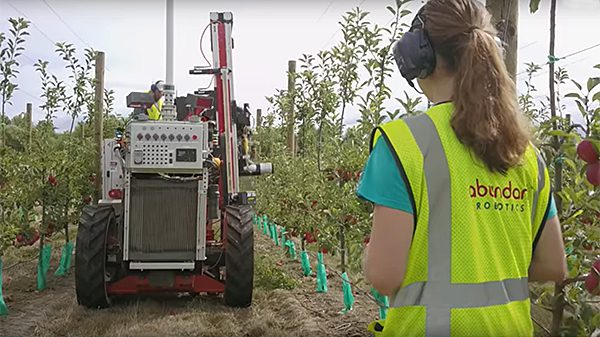As practically everyone in the industry knows, there are strong pressures to hasten the mechanization of fruit and vegetable production. The biggest reason, of course, is the dwindling availability of farm labor.
How far has mechanization advanced? Not very far, at least in regard to harvesting technology, according to a recent report issued by Western Growers Association BB #:144734. The report is the result of WGA’s Global Harvest Automation Initiative, launched in February 2021.

“Primarily, the study finds that the overall advancement of harvest automation in the fresh produce industry is so far limited, mainly due to the technical difficulties in replicating the human hand to harvest delicate crops,” the report notes in its executive summary.
The study focused on six crops: apples, blueberries, strawberries, broccoli, lettuce, and almonds.
Of these, only almonds have achieved “virtually 100% mechanization” in recent decades.
For the other crops, most progress has been made in preharvest activities, such as weeding and thinning, and harvest assist activities, such as harvesting platforms and autonomous ground vehicles.
“Looking ahead, growers have high expectations of advancement across pre-harvest and harvest assist activities, reaching an average of 30-60 percent by 2025,” says the report. “Expectations for harvest automation are more reserved, reaching on average 20 percent by 2025.”
Labor pressures are not expected to relent. The growers covered by the survey reported that in 2021, labor costs accounted for 53 percent of total production costs (versus 46 percent in 2019). Most growers expect that labor costs will rise another 10-30 percent in the next three to five years.
Furthermore, although food prices to consumers rose by 88 percent from 1990 to 2020, the average specialty crop price rose by only 17 percent, putting margin pressures on growers.
Over the same period, the ratio of net to gross farm income decreased by 12 percent. Levels have been relatively stable since 2015.
Up to this point, “savings on harvest cost through automation are small due to limited advancement,” says the report.
Of the five fruit and vegetable crops studied, blueberries have achieved the greatest cost savings through automation (60 percent on a cost of $14,500 per acre). But for the most part, automated harvesting has been used for berries dedicated to freezing or juicing. Although the harvesting technology for fresh blueberries has advanced, it has had the corresponding cost of high shrinkage (25 percent).
“When harvesting, a machine will shake the blueberry bush and capture all of the berries that fall off, regardless of ripeness or quality,” notes the report.
Of the other four fruit and vegetable commodities, apples, strawberries, lettuce, and broccoli used practically no harvest technology (except for harvest assist devices).
The study recommended the following approaches for improving harvest mechanization: genetic innovation, new farming operations, industry collaboration, policy change and transparency, and focusing on the next generation of the ag workforce.
One example of genetic innovation is Bayer’s development of a high-rise broccoli, with taller and more uniform stems and fewer leaves. This would reduce the number of passes needed to harvest the crop.
As for robot technology, it remains in the early development stage, the report indicated, “measured in terms of funding received, number of paying customers and number of robots in service.”
Most of the startups in this area are in the preventure or seed round, and about 75 percent have fewer than five paying customers and/or five robots in operation.



